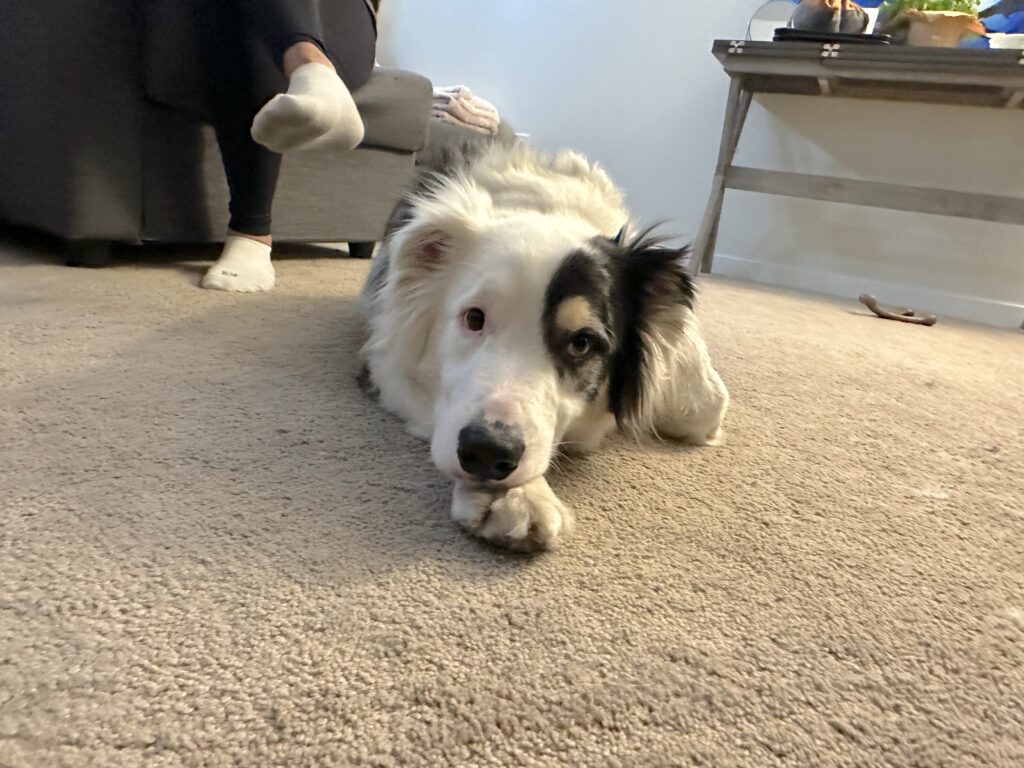An Easy Way of Stopping Dog on Dog Aggression
By: David Codr
Published Date: February 12, 2024
For this Omaha dog behavior training session we worked with 2 year-old Australian Shepherd Zuko; sharing a tips for stopping dog on dog aggression.
Zuko’s guardians reached out due to his barking and lunging at unknown dogs who are larger than he is. He doesnt do it with every dog, but obviously no one wants to have a dog who acts ggressive around other dogs.
I worked wirth Zuko over three sessions, one a week for 3 consecuitive weeks. Dog behavior modificaiton is a numbers game, you need to practice consistently in short successful sessions. These don’t thave to be hour long sessions. In fact, I usually recommend my clients keep them short and more frequent.
We started off by establishing a solid foundation. We introduced and loaded a marker word, used hand tageting for the guardian to develop good timing, went over dog body language consent and cut off signals as well as other foundational elements like celebrating desired behaviors and some createie exercise tips.
I also suggested they stop using a tool that I have found is a cause of many dog reactiveity problem. More on that later.
In the second session we built on the success of our intitial session and introduced some more complex exercises. I shared some loose leash walking tips before turning my attention to the dog aggression problem.
Stopping Dog on Dog Aggression
After working with over 4,000 dogs as Omaha’s Dog Behavior expert, I have found many dogs who are labeled as “aggressive dogs” arent actually aggressive – they are reacting out of fear, insecurity or anxiety. A common cause for this is a lack of positive early socialization. This is one of the reasons I started our puppy classes. Many aggresive dog problems can be avoided by positively socializing your puppy when it is young, before 4 months.
Another reason dogs act aggresively are negative experiences with other dogs. This can come from a fight of course, but also for humans disagreeing with a dog who growls (never disagree with a growling dog) to communicate they dont like another dog getting too close or the humans using aversive training tools like a prong collar.
Putting on a hat to give you a skill like being a doctor would be awesome. But its not reality for humans and the same thing applies to dogs. There is no collar or harness that stops dogs from pulling on a leash. Sadly, many people turn to pinch collars, prong collars, shock collars which only punish mistakes.
Think about it, how would you like it if your boss decided to train you by punishing your mistakes but not teaching you what to do in the first place? That would be ridiculous, but sadly that is something that happens to dogs all the time. Its not hard to train a dog to walk with a loose leash, but it doesnt require teaching them first.
Not only do these punishment based tools not work, they often cause unintended consequences that are far worse than pulling on the leash. Why? Anything a dog is looking at or nearby when a the collar bites or the shock comes is where the dog thinks it comes from. Since dogs who arent trained to walk with a loose leash pull hundreds or more times on each walk, using those tools is a great way to train a dog to act aggressively to other dogs.
A much better way to stop a dog from acting aggressive when it sees other dogs is to crate a positive association. I do this by doing something I like to call click for looks. Not only is this an easy way to stop dog aggression, it can work on people, skateboards and just about anything a dog may not like.
I didn’t have a chance to film this technique when we did it with Zuko as it was getting late in the day, but have done this exercise for hundreds of dogs who act aggressively towards other dogs. Im including a video from another session on this secret to stopping dog aggression here. If you have a dog with dog on dog aggressive behavior, you should watch the free positive dog training video below.
By clicking, then treating a dog for looking at something, you can help them stop feeling like its a negative and instead start creating what we call a positive emotional response. This is essentialy the opposite of using a prong collar.
The most important thing is the dog’s handler needs to keep the dog just far enough away that it doesnt think the scary thing is too close. Over time you can get closer, but its crucial you go at the dog’s pace. If the dog reacts, wont take the treat or shows other signs of distress, you are too close and need to move further away.
I often advise my cleints to keep score. The number of times the dog looks at the other dog (or anything you are working on) without barking versus the number of times the dog reacts. Your goal being lots of clicks and no reactivity.
Zuko did great, getting very close to dogs playing nearby and easily looking away after his initial look. It will take time, practice and a lot of treats, but based on how great his guardians did and the fact they stopped using the prong collar, Zuko will continue to improve.
These were some fun and productive in home Omaha dog training sessions. We may be back to work with Zuko on his loose leash walking, but his days of acting aggressive to other dogs will soon be a memory only.
If your dog is aggressive with other dogs or people, check out more info on our in-home dog training and loose leash walking sessions.
Categorized in: Dog Behavior


